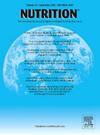Reduction of food insecurity over time: An unattainable reality for the poorest families?
IF 3.2
3区 医学
Q2 NUTRITION & DIETETICS
引用次数: 0
Abstract
Introduction
Food insecurity (FI), associated with inadequate access to food, reflects social inequality. Shifts in sociodemographic factors significantly impact household FI. This study initially hypothesized that the progression of the COVID-19 pandemic would exacerbate socioeconomic challenges, thereby influencing the trends and responses related to FI within the studied population.
Objective
This study examines how social and demographic factors associated with FI change in an important population group during a health crisis, identifying vulnerable groups.
Methods
This longitudinal study analyzed a random sample of students from public schools in two Brazilian municipalities. Data were collected at 9-month intervals at four time points (T0, T1, T2, and T3) between 2020 and 2022. FI was measured using the Brazilian Food Insecurity Scale (BFIS) and analyzed as a discrete numerical variable (BFIS score -0 to 14 points). Comparisons across time points were analyzed using the paired Wilcoxon test. A generalized linear mixed model assessed the relationship between BFIS score and social and demographic variables over time.
Results
The average BFIS scores declined from 2.9 at T0 to 2.7 at T1; to 2.2 at T2 and T3, with significant differences between T0 and T2/T3 (P < 0.001), and T1 and T2/T3 (P = 0.017). Higher BFIS scores were associated with families earning less than or equal to half the minimum wage Rate Ratio (RR) =4.93 [95% CI: 3.81–6.36], enrolled in social programs RR =1.14 [95% CI: 1.02–3.81], receiving emergency aid RR =1.15 [95% CI: 1.04–1.28] or food baskets RR=1.30 [95% CI: 1.18–1.43]. Families headed by Black/Brown individuals and women had higher BFIS scores, as did those headed by single individuals and those with low educational attainment.
Conclusion
There was no reduction in the average BFIS score for 2020 and 2022 for extremely poor families, despite improvements in other socioeconomic indicators. Families enrolled in social programs, beneficiaries of emergency aid, and households headed by women and black people experienced higher average BFIS scores, highlighting factors in the complex dynamics of FI during COVID-19 and a dynamically oscillating evolution in the sociodemographic landscape.

长期减少粮食不安全:最贫困家庭无法实现的现实?
粮食不安全(FI)与粮食获取不足有关,反映了社会不平等。社会人口因素的变化显著影响家庭FI。本研究最初假设,COVID-19大流行的进展将加剧社会经济挑战,从而影响研究人群中与FI相关的趋势和反应。目的:本研究探讨在健康危机期间与重要人群FI变化相关的社会和人口因素,确定弱势群体。方法本纵向研究分析了巴西两个城市公立学校的随机学生样本。在2020年至2022年的4个时间点(T0、T1、T2和T3)每9个月收集一次数据。FI使用巴西粮食不安全量表(BFIS)进行测量,并作为离散数值变量进行分析(BFIS得分为-0至14分)。跨时间点的比较采用配对Wilcoxon检验进行分析。一个广义的线性混合模型评估了BFIS分数与社会和人口变量之间的关系。结果患者的平均BFIS评分由T0时的2.9分下降至T1时的2.7分;至2.2,T0和T2/T3之间有显著差异(P <;T1和T2/T3 (P = 0.017)。较高的BFIS分数与家庭收入低于或等于最低工资的一半相关比率(RR) =4.93 [95% CI: 3.81-6.36],参加社会计划的RR= 1.14 [95% CI: 1.02-3.81],接受紧急援助的RR= 1.15 [95% CI: 1.04-1.28]或食品篮子RR=1.30 [95% CI: 1.18-1.43]。以黑人/棕色人种和女性为户主的家庭的BFIS得分较高,以单身人为户主的家庭和受教育程度较低的家庭也是如此。结论:尽管其他社会经济指标有所改善,但2020年和2022年极端贫困家庭的BFIS平均得分没有下降。参加社会项目的家庭、紧急援助受益人以及以妇女和黑人为户主的家庭的BFIS平均得分更高,这凸显了2019冠状病毒病疫情期间FI复杂动态的因素,以及社会人口格局的动态波动演变。
本文章由计算机程序翻译,如有差异,请以英文原文为准。
求助全文
约1分钟内获得全文
求助全文
来源期刊

Nutrition
医学-营养学
CiteScore
7.80
自引率
2.30%
发文量
300
审稿时长
60 days
期刊介绍:
Nutrition has an open access mirror journal Nutrition: X, sharing the same aims and scope, editorial team, submission system and rigorous peer review.
Founded by Michael M. Meguid in the early 1980''s, Nutrition presents advances in nutrition research and science, informs its readers on new and advancing technologies and data in clinical nutrition practice, encourages the application of outcomes research and meta-analyses to problems in patient-related nutrition; and seeks to help clarify and set the research, policy and practice agenda for nutrition science to enhance human well-being in the years ahead.
 求助内容:
求助内容: 应助结果提醒方式:
应助结果提醒方式:


